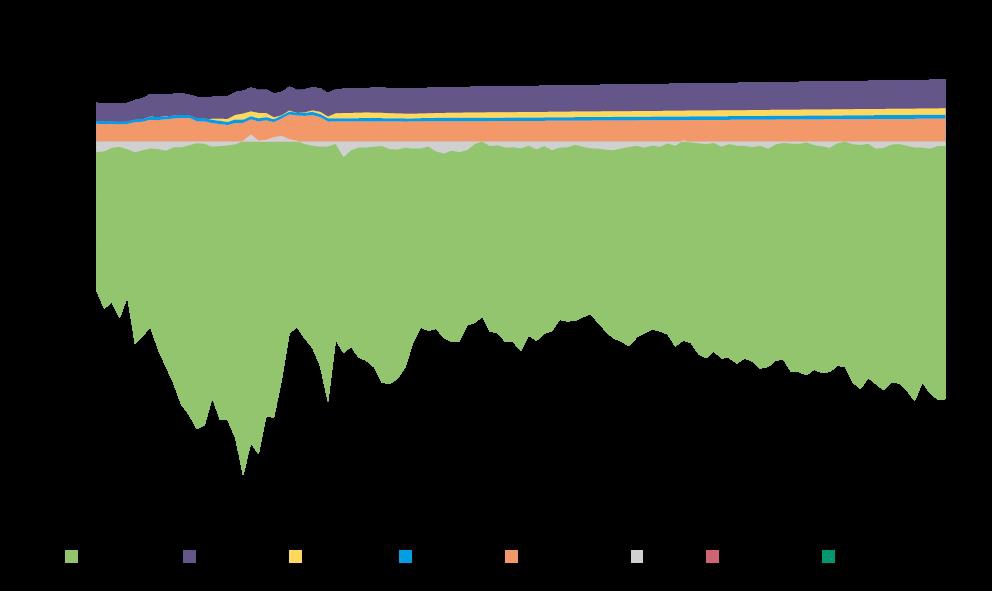5.5 Projections of the LULUCF sector
5.5.1 Method and assumptions
New projections of removals and emissions from the LULUCF sector were published by the Norwegian Institute of Bioeconomy Research (NIBIO) in October 2022. The projections cover removals and emissions of all greenhouse gases in the LULUCF sector from 2021 to 2100 based on the Climate Convention and the LULUCF regulation under the EU climate and energy 2030 framework, respectively. The projections include all land categories, and take the following existing policy measures into account: Increased seedling density, enhanced breeding of forest seedlings, fertilization of forest and protection of 10 per cent of the forest area.
The Norwegian Institute of Bioeconomy Research (NIBIO) based the projections on the best available and most updated data and models. The reference period was from 2006 to 2020. The projection is based on the SiTree model, updated numbers from The National Forest Inventory (NFI) database and the RCP 4.5 climate scenario.
The SiTree model is an individual growth simulator, and imputation methods to project the future growth, mortality, ingrowth, and natural regeneration. The emissions and removals of total soil organic C (dead wood, litter, and soil pools) from forest land on mineral soil are estimated using the decomposition model Yasso07 (NIBIO 2022).
5.5.2 Projections
Figure 5.4 shows net removals and emissions of greenhouse gases from 1990 to 2020 (historical data) and projections until 2100 for all categories in accordance with the reporting to the UNFCCC. The categories include emissions from areas in transition to the category and areas remaining in their category (i.e. was the same category in 1990, or changed category more than 20 years ago).
Figure 5.5
Figure 5.6 Total net emissions from all categories.

The categories include emissions from areas in transition to the category and areas remaining in their category (i.e. was the same category in 1990, or changed category more than 20 years ago).
Source: Norwegian Institute of Bioeconomy Research.
Table 5.8 Net removals (mill tonnes CO2 eq) in the LULUCF sector (historic and projections.)
1990 | 2005 | 2010 | 2020 | 2025 | 2030 | 2035 | |
|---|---|---|---|---|---|---|---|
LULUCF | -10.5 | -20.3 | -23.7 | -20.3 | -15.9 | -16.5 | -13.6 |
Source: Norwegian Institute of Bioeconomy Research
The total net removals of the LULUCF-sector for the historic period 1990–2020 and projections for 2030 are given in table 5.6.
The projections show that the total sink is expected to be reduced in the period 2021–2030. The projections indicate that the carbon sink capacity of the current forest stock has reached a peak. This is primarily due to a skewed age class structure of the Norwegian forest with 43 per cent mature stands. Due to ageing forests and higher harvesting rates, the annual increment and removals will inevitably decline between 2030 and 2050. Nevertheless, since the annual timber harvest is approximately 50 per cent of the annual increment, the carbon stocks in the Norwegian forests are still increasing. The projections indicate that the forests’ capacity to act as a sink will increase again after 2050 towards 2100 due to the implementation of new forest management measures, a more normal age class structure, and better growing conditions due to global warming. However, the projections do not directly model the increased risk of damages from climate change, as the input data on damages are from the historical reference period.
5.5.3 Sensitivity analyses for LULUCF
The Norwegian Institute of Bioeconomy Research (NIBIO) has carried out a sensitivity analysis of some of the most important parametres for the LULUCF sinks and sources. More specifically, they have analysed the effects of climate change (climate scenario RCP8.5, as well as an average between RCP 4.5 and RCP 8.5, and different climate models for scenario RCP 4.5), effects of land-use change (deforestation and land-use change from forest land and wetlands on organic soil to other land-use categories), and soil carbon change in forest land remaining forest land (soil model parameters for litter with different climate models).
Their analysis shows that the estimated net removals in the LULUCF sector will be fairly unaffected by differences in the selected climate scenarios until 2050. Most of the land-use categories are expected to remain in the “cool temperate moist” climate zone (at least until 2050). NIBIO has not analysed the sensitivity of forest developement between climate change scenarios for the period after 2050 due to uncertainties related to the effects of natural disturbances caused by future climate extrems.
The analysis of soil carbon change in forest land remaining forest land, related to variations in litter input parameters combined with different climate models for RCP 4.5. This resulted in mean annual net removals for the period 2021–2050 of 5358 kt CO2 with a mean deviation corresponding to +74% to -50%, reflecting an uncertainty range in mean annual removals of 2 664 – 9 309 kt CO2.
As for deforestation, applying a high deforestation rate of 11.3 kha per year (upper 95 per cent conf.int.) may result in an increase of GHG emissions of approximately 1 633 kt and 2 878 kt CO2-eqv. per year in 2030 and 2050, respectively. Applying a low deforestation rate of 1.5 kha per year (lower 95 per cent conf. int.) may result in a reduction of GHG emissions of approximately 1 412 and 2 467 kt CO2-eqv. per year in 2030 and 2050, respectively.
Furthermore, NIBIO created a scenario in which future land-use change related to drainage and removal of organic soil in forests and peatlands is halted. This would encompass approximately 1.2 kha per year and would lead to a reduction of GHG emissions of 251 and 552 kt CO2-eqv. per year in 2030 and 2050, respectively.